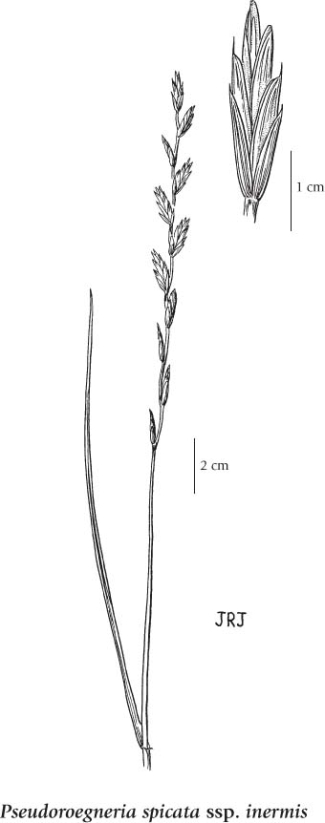Pseudoroegneria spicata subsp. inermis (Pursh) Á. Löve
bluebunch wheatgrass (beardless wheatgrass)
Poaceae (Grass family)
Introduction to Vascular Plants
bluebunch wheatgrass (beardless wheatgrass)
Poaceae (Grass family)
Introduction to Vascular Plants
Map
Distribution of Pseudoroegneria spicata subsp. inermis
Click here to view the full interactive map and legend
Species Information
General:
Perennial, tufted grass from fibrous roots, often forming clumps up to 150 cm wide; stems 60-130 cm tall, erect, slender, green or glaucous.
Leaves:
Mostly stem leaves; sheaths usually smooth or minutely hairy, the hairs pointed downward; blades 1-4 mm wide, flat to loosely in-rolled, usually smooth below, short-hairy above, rarely hairy on both surfaces; ear-shaped lobes at the leaf-bases well-developed; ligules scarcely 1 mm long, minutely ragged and fringed.
Flowers:
Inflorescence a spike, 8-16 mm long, middle internodes 0.8-2.5 cm apart; spikelets 5- to 8-flowered, mostly 1 spikelet per node; glumes 6-15 mm long, 0.9-2.2 mm wide, nerves evenly smooth or rough; lemmas 10-14 mm long, nerved, awned or unawned, the awns 0-20 mm long.
Notes:
Awned and unawned specimens differ by a single gene, a difference that some taxonomists (Barkworth 1994) feel does not merit separate taxonomic recognition. Most BC plants are unawned. A key to the two forms follows:
1. Lemmas awned, 10-20 mm long, widely divergent........................... ssp. Spicata
1. Lemmas unawned or nearly so, 0-2 mm long, straight ............................ssp. inermis (Scribn. & J.G. Sm.) A. Love
Illustration

If more than one illustration is available for a species (e.g., separate illustrations were provided for two subspecies) then links to the separate images will be provided below. Note that individual subspecies or varietal illustrations are not always available.
Illustration Source: The Illustrated Flora of British Columbia